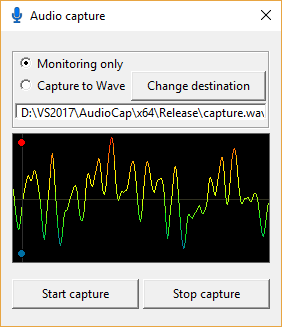Introduction
This 64-bit Visual Studio 2017 community project is intended to perform real time audio capture of anything playing on your PC.

While it could be used to record from the microphone, the best quality is achieved when using a multiplex audio card and recording from the "Stereo mix" device.
How to Use AudioCap
- Start
AudioCap. - Start playing a movie (with a sound track) or a local or internet audio file (streaming).
- Press the [Start capture] button, to see the oscilloscope PCM WIMDATA curve.
- Check "Capture to Wave" if you want to create the "capture.wav", or check "Monitoring only" if you want to see only the peak level.
Background
The original version was written long ago at the time of XP in PowerBASIC.
Using the Code
Here is the OpenWaveIn function that can be customized to use a specific device.
Search for:
if ((DeviceToUse == MICROPHONE) && (StrStrI(wic.szPname, L"micro"))) { break; } if ((DeviceToUse == STEREO_MIX) && (StrStrI(wic.szPname, L"stereo"))) { break; }
DWORD OpenWaveIn(IN HWND hParent, IN long UseWaveFormat, IN long DeviceToUse) {
WAVEINCAPS wic = { 0 };
WORD zBitsPerSample = 0, zChannels = 0;
LONG zSamplesPerSec = 0, I = 0;
DWORD nRet = 0;
switch (UseWaveFormat) {
case WAVE_FORMAT_1M08: zChannels = 1; zSamplesPerSec = 11025; zBitsPerSample = 8;
break;
case WAVE_FORMAT_1S08: zChannels = 2; zSamplesPerSec = 11025; zBitsPerSample = 8;
break;
case WAVE_FORMAT_1M16: zChannels = 1; zSamplesPerSec = 11025; zBitsPerSample = 16;
break;
case WAVE_FORMAT_1S16: zChannels = 2; zSamplesPerSec = 11025; zBitsPerSample = 16;
break;
case WAVE_FORMAT_2M08: zChannels = 1; zSamplesPerSec = 22050; zBitsPerSample = 8;
break;
case WAVE_FORMAT_2S08: zChannels = 2; zSamplesPerSec = 22050; zBitsPerSample = 8;
break;
case WAVE_FORMAT_2S16: zChannels = 2; zSamplesPerSec = 22050; zBitsPerSample = 16;
break;
case WAVE_FORMAT_4M08: zChannels = 1; zSamplesPerSec = 44100; zBitsPerSample = 8;
break;
case WAVE_FORMAT_4S08: zChannels = 2; zSamplesPerSec = 44100; zBitsPerSample = 8;
break;
case WAVE_FORMAT_4M16: zChannels = 1; zSamplesPerSec = 44100; zBitsPerSample = 16;
break;
case WAVE_FORMAT_4S16: zChannels = 2; zSamplesPerSec = 44100; zBitsPerSample = 16;
break;
default: zChannels = 1; zSamplesPerSec = 22050; zBitsPerSample = 16;
}
LONG nDev = (LONG) waveInGetNumDevs();
for (I = 0; I < nDev; I++) {
nRet = waveInGetDevCaps(I, &wic, sizeof(wic));
if (nRet == 0) {
if (wic.dwFormats & UseWaveFormat) {
gCap.wfx.nChannels = zChannels;
gCap.wfx.nSamplesPerSec = zSamplesPerSec;
gCap.wfx.wFormatTag = WAVE_FORMAT_PCM;
gCap.wfx.wBitsPerSample = zBitsPerSample;
gCap.wfx.nBlockAlign = gCap.wfx.nChannels * gCap.wfx.wBitsPerSample / 8;
gCap.wfx.nAvgBytesPerSec = gCap.wfx.nSamplesPerSec * gCap.wfx.nBlockAlign;
gCap.wfx.cbSize = 0;
nRet = waveInOpen(&gCap.hWaveIn, I, &gCap.wfx,
(DWORD_PTR) gCap.hAudioWnd, (DWORD_PTR)gCap.hAudioWnd, CALLBACK_WINDOW);
if (nRet == 0) {
if ((DeviceToUse == MICROPHONE) &&
(StrStrI(wic.szPname, L"micro"))) { break; } if ((DeviceToUse == STEREO_MIX) &&
(StrStrI(wic.szPname, L"stereo"))) { break; } }
} else {
nRet = 22; }
}
}
return nRet;
}
And here is a link to show you how to setup Windows to enable the hidden "Stereo mix" mode. .
Points of Interest
The code is written in full procedural mode, using only the core flat API SDK, to be easily translated from one language to another. The AudioCap.h section has been designed to also be easily turned into a DLL.
You can find more free contributions on my private forum www.objreader.com, especially if you like graphic, multimedia, OpenGL and 3D wavefront model viewer.
